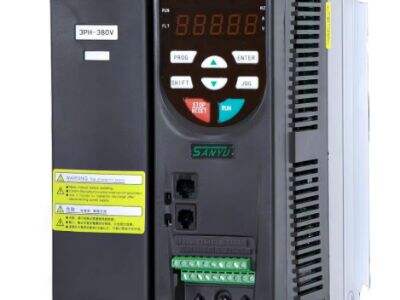هل سبق وأن تساءلت عن كيفية عمل الأجهزة مثل المصاعد ومكيفات الهواء؟ هذه أجهزة مفيدة جدًا، وتعمل بمساعدة شيء يُعرف باسم المحرك الكهربائي. المحركات الكهربائية هي فئة خاصة من الآلات التي تحتاج إلى طاقة كهربائية للعمل، كما تحتاج أيضًا إلى جهاز يُعرف باسم محوّل التردد ليعمل بشكل أفضل وأكثر كفاءة. سنكتشف في هذا المقال ما هو محوّل التردد وكيف يمكنه مساعدة المحركات الكهربائية على أداء وظائفها.
ما هو مُحَوِّل التردد؟
محوّل التردد هو جهاز مثالي يدير سرعة وقوة تشغيل المحرك. يقوم بذلك عن طريق تغيير الطاقة المرسلة إلى المحرك. يمكن للمحرك تعديل سرعته وقوته عندما تتغير الكهرباء. هذا يعني أن المحرك يمكن أن يسرع عندما يكون عليه العمل بجد أكثر، ويتباطأ عندما لا يحتاج إلى القيام بمجهود كبير. وعلى الرغم من أن هذا قد يبدو معقدًا بعض الشيء، إلا أن هذه طرق بسيطة وفعالة للغاية لتحكم المحرك ليقوم بالكمية المناسبة من العمل لإتمام المهمة المطلوبة.
تقليل الاستهلاك باستخدام محولات التردد
توفير كميات كبيرة من الطاقة هو أحد أفضل مزايا محول التردد. وهذا مهم جدًا لأن توفير الطاقة يخفض فواتير الكهرباء ويكون أفضل لكوكبنا. يعمل المحرك الكهربائي العادي غالبًا بسرعة واحدة طوال الوقت، حتى عندما لا يحتاج إلى العمل بجهد كبير. هذا يمكن أن يؤدي إلى هدر للطاقة، حيث يستخدم نفس كمية الطاقة.
ولكن مع محول التردد، يمكن تشغيل المحرك بسرعته وعزم دورانه الأمثل حسب العملية التي يقوم بها. إذن، عندما لا يحتاج المحرك إلى العمل بجهد أكبر، فإنه يبطئ ويستهلك طاقة أقل، على سبيل المثال. هذا يوفر المال ويقلل من التلوث، رابح في كلتا الحالتين للبيئة.
كيف يعمل محول التردد؟
يتكون محول التردد النموذجي من ثلاث مكونات رئيسية، وكلها تتكامل لمساعدة في التحكم بالمحرك:
محول التيار: هذا المكون يحول الطاقة الواردة إلى نوع آخر من الكهرباء يُسمى طاقة التيار المستمر (DC). إنه مثل إعادة تشكيل قطعة لغز بحيث تناسب بشكل أفضل.
الحافلة DC: تُستخدم كوعاء تخزين لحفظ الطاقة الكهربائية. تحفظ الطاقة لاستخدامها لاحقًا عندما يحتاج المحرك إليها.
المحول: هذا الجهاز يقوم بتحويل الطاقة المخزنة من طاقة التيار المستمر (DC) إلى طاقة التيار المتردد (AC)، والتي تعمل عليها معظم المحركات الكهربائية. ينقل الكهرباء إلى المحرك الكهربائي ويمكنه تعديل الكهرباء لتحديد مدى سرعة دوران المحرك الكهربائي.
يمكن للمحول الترددي ضبط الكهرباء إلى المحرك ليعمل بالسرعة الصحيحة لكل مهمة.
لماذا هم محولات التردد مهمون للمحركات؟
هناك عدة طرق يمكن بها لمحركات الكهرباء أن تعمل بشكل أفضل مع المساعدة من مغيرات التردد. فهي تمكن المحركات من العمل بسلاسة وهدوء عبر نطاق واسع من السرعات. وهذا مهم بشكل خاص في حالة الآلات مثل المصاعد والسلالم المتحركة حيث يبدأ المهمة بالبدء والوقف مع أقل اهتزاز. هذا التشغيل السلس يقلل من التآكل والاحتكاك في الآلات، مما يسمح لها بأن تدوم لفترة أطول وتتطلب صيانة أقل.
الثاني هو أن مغيرات التردد تمكن المحرك من البدء تدريجياً. يُطلق على هذا "البداية الناعمة"، وهو مفيد للمحرك لأنه يضع ضغطاً أقل على المكونات الكهربائية والميكانيكية. وأخيراً، يمكن لمغيرات التردد أيضاً أن تقوم بوظائف مفيدة جداً مثل حماية المحرك من المشاكل مثل الإجهاد الزائد أو الدوائر القصيرة التي قد تضر به.
مزايا وعيوب محركات المغيرات
بالإضافة إلى ذلك، استخدام مغيرات التردد له العديد من المزايا. أولاً، تمنع هدر الطاقة، مما يقلل من فواتير الكهرباء. وهذا جيد للكلا من المنازل والشركات! ثانياً، تسمح مغيرات التردد للمحركات الكهربائية بالعمل بشكل أكثر سلاسة وهدوءاً. إنها تنظم عمل الآلات المختلفة وتضيف إلى راحتها. وأخيراً، توفر المحركات ميزات الأمان، مما يقلل من الحوادث والأضرار على المعدات عند استخدامها.
مراكز مراكز التحكم في العمليات الرقمية» المستخدمون لمحولات التردد، لكن هناك عيوب محتملة لاستخدام محولات التردد. أولاً، فهي مكلفة ومعقدة التركيب والتشغيل، مما يجعلها غير مناسبة لكل تطبيق أو عمل. وفي الوقت نفسه، بما أن محولات التردد يمكن أن تولد ضوضاء كهربائية قد تؤثر على الأجهزة الإلكترونية القريبة منها، فهذا قد يكون مزعجًا. وأخيرًا، يمكن أن تولد محولات التردد حرارة أثناء العمل، مما قد يشكل مشكلة في المناطق الأصغر أو المغلقة حيث تكون مساحة التهوية محدودة.

 EN
EN
 AR
AR
 BG
BG
 HR
HR
 CS
CS
 DA
DA
 NL
NL
 FI
FI
 FR
FR
 DE
DE
 EL
EL
 HI
HI
 IT
IT
 JA
JA
 KO
KO
 NO
NO
 PL
PL
 PT
PT
 RO
RO
 RU
RU
 ES
ES
 SV
SV
 CA
CA
 TL
TL
 IW
IW
 ID
ID
 LV
LV
 LT
LT
 SR
SR
 SK
SK
 SL
SL
 UK
UK
 VI
VI
 SQ
SQ
 GL
GL
 HU
HU
 MT
MT
 TH
TH
 TR
TR
 MS
MS


